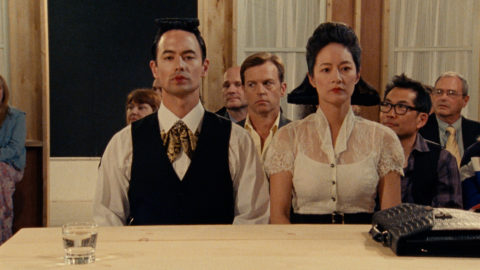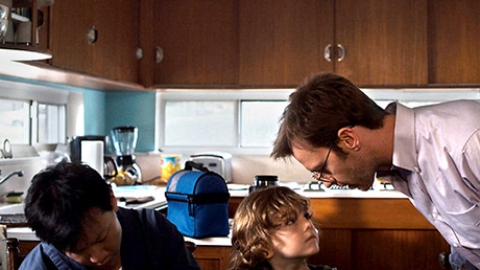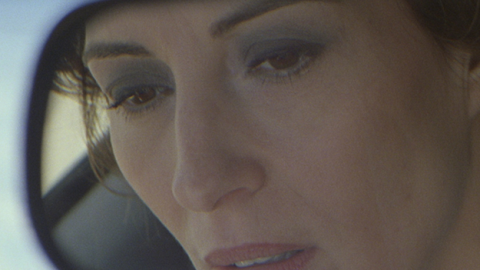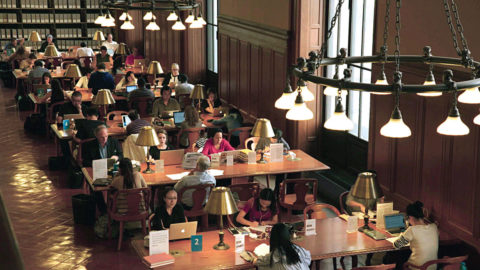Interview: Patrick Wang
“They once baked bread here, but now we live in an age of crumbs. But what they make of these crumbs is miraculous, and we are lucky to have them,” a character remarks of the titular bakery-turned-performance-space in Patrick Wang’s beguiling A Bread Factory. A true independent spirit, Wang knows how to prepare a feast from crumbs, having self-distributed his work ever since festival committees found his 2011 debut In the Family unsuited to any of their tidy boxes. Despite its regional Tennessee setting and concern with LGBT custody rights, In the Family is the opposite of a sanctimonious “issue” movie, and its 169-minute runtime invites the viewer to inhabit its richly textured world rather than survey straw-man villains and prefabricated lessons. Film Comment called it “at once so moving and so urgent—a portrait of a family that doubles as a snapshot of a nation.”
Seven years later Wang returns with two—or perhaps three—follow-ups: another closely observed portrait of bereavement and unorthodox family units, The Grief of Others, which Wang discussed in Film Comment in 2015 following its appearance at SXSW, Cannes, and other festivals; and A Bread Factory,a two-part paean to community theater (and communities in general). In my review in the November/December 2018 issue, I wrote: “In Patrick Wang’s deceptively tranquil, flawlessly acted, formally subversive A Bread Factory, a converted bakery that’s brought performances to a small hamlet in upstate New York for 40 years now clings precariously to public funding. In passages heartbreakingly familiar to anyone who’s had to panhandle to bureaucrats who misguidedly conflate progress with sensation, elderly founders and life partners Dorothea (Tyne Daly, impassioned and idealistic) and Greta (Elisabeth Henry, conciliatory and serene) beseech town council members not to divert their subsidy to some tacky new performance artists.”
On a snowy afternoon last week Wang sat down with me in New York to consider how art fulfills vital societal needs, and the ways in which his breadth of experience informs both the subjects of his films and his strategies for delivering them to the public.
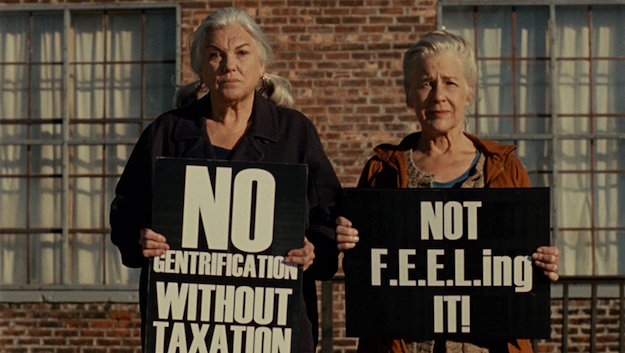
A Bread Factory
You have backgrounds in both theater and economics.
Guilty.
Could you talk about reconciling those two backgrounds, and how they inform you as a filmmaker, or perhaps how the econ background informs you as a distributor?
I’ll start with the piece that is clearest to me—the connection between economics and filmmaking. Contrary to what a lot of people may think, it’s not on the business side, it’s not the distribution. It’s really in how I see information. As you may know of economists, people don’t turn the economy over to us and let us run experiments. A lot of the information we get is indirect. We have to infer things about why people made those decisions and what was acting upon them. That way of looking at what people reveal indirectly, the empirical work, is also how I see my characters. I don’t feel, setting out, that I know everything about them. Bit by bit they reveal things to me. And then I learn about them, like in life, through those channels of information.
It sounds like your films are not very formed when you sit down to write them but then they take shape during the writing, rehearsal, and production.
You’re right in that when I sit down to write, generally I don’t know the most important elements of plot, and I may only have the most surface impressions of a character. And sometimes they are ludicrous. I sat down to write a part of A Bread Factoryand I just started with a note. You know: “insert young love story.” And it can turn into something as awful as its beginnings make it sound or it can really surprise you. I quite loved that young love story and then it slipped into something else that surprised me.
I remember shortly after I wrote the script I was visiting a friend in Buenos Aires. We were playing with his kids. He was like, “Wow, how do you come up with all this? How do you create all these details and all these characters?” I told him, you would probably recognize it because it’s not unlike us being here with your kids now. They’ve run in and out of the room, and in the moment you’re just like, “Why are you crying? Take that out of your mouth. Stop hitting him.” You’d get these shards. I feel like with my characters you can control them no more or no more effectively than you can control your kids. If anything, you want to watch them and you want to learn from them. Moving through [these] films, a lot of audience members seem to feel surprised. Things don’t quite happen as they might expect. That’s probably because things don’t quite happen as I expect. There’s a lot of elements within your control, but in terms of the raw elements as they start coming in, it feels very much outside of myself. You’re sort of given the care and the little puzzle of figuring it out.
By the time we start to involve other crew, other actors, the script is set. What I like to do in rehearsal and what I like to do in design with my department heads is look for the spaces that still exist even though something is set. In film, we talk about improvisation as if we’re writing lines or as if we’re inventing scenes, but there are many more dimensions for improvisation that an actor still has if you leave them room. The trick is always you have to leave enough space for people to do their work, but you give them something to hook onto. That kind of anchor allows for the other elements of improvisation to be much freer.
A phrase I come back to is “breathing room” and I think that’s less about the runtimes of your films than about the kind of performative flexibility that you’re describing. There are also silences and stillnesses. Scenes don’t begin with dialogue all the time: there are beats before characters start speaking or after characters leave the room. Could you talk about all of that?
I think it was Arthur Miller who said that you write all these words to try to express the things in our silences. And in those silences, it’s often when actors are doing a lot of work. If you are talking about a moment after someone leaves the room or a moment of silence when the actors are not communicating something necessarily dense in that moment, the space is communicating something. Or the type of living in a space is communicating something. In a couple of my movies, there’s something so simple as hearing a lawnmower from the neighbor’s yard. Elements of what it’s like to be in somebody else’s house, what it’s like being there alone in the morning. I think that there is room for all of these cues, which are in my memories, and if you’re trying to create some memory in a film, you need that observational space. We say silence, meaning no words, but there is a lot of sonic design and richness and information in those scenes.
And mise en scène isn’t limited to what’s put in the scene, it’s the sense that there are realities outside of the frame. Does your theater background attune you to that?
I’m never sure, because there are so many different types of theater and film. What I’ve learned from theater is a literary appreciation, a literary foundation, literary values, as well as values for what actors can accomplish. There are probably also elements of flexibility with sound and lighting and other things that may come into play. But it’s probably more values than anything else, and the particular experience I had with dramatic form, dramaturgy, dialogue, and working with actors.
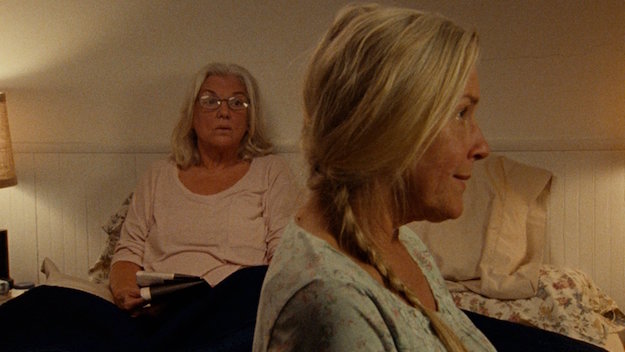
A Bread Factory
One thing that’s immediately striking is that you favor long takes in wide-screen compositions. Often you have two characters facing each other in the frame and speaking, rather than the traditional grammar of shot/reverse shot and close-up response. That feels theatrical but also highly cinematic, in that it gives us a sense of unbroken flow, of life in real time.
Right. I can have what looks like a proscenium view of a scene [when] I’m in the audience looking at the stage. But [when] I move it from the theater to film, I am close enough to feel like a participant in the room—close enough to be able to see certain expressions that may not be able to see on the stage, to hear subtleties of vocal expression that I may not be able to get on stage. Suddenly it’s a completely different game, and it’s a game that I’m only starting to understand. It’s a participatory perspective. It makes film feel much more like personal memory than theater. We have memories of theater and we have memories of film, but a certain kind of perspective makes it feel like mymemory. Especially if there’s room in there for you to choose how to interpret that. And that feels very much like memory, when we go back and we reinterpret, based on the raw materials of what we were able to observe in a scene.
When Dorothea calls the young journalist up on stage and says, “Everything looks different from up here,” that seems to be what you’re doing to the viewers. You’re repositioning us and you’re showing us a view that looks different from what we’re accustomed to.
In A Bread Factory there are times when you can look at that distinction I was just talking about where you are sitting in the audience, because we make liberal use of the zoom. By the end of the scene, you’re actually much closer. You can feel that transformation literally in the scene.
Do you see yourself as working in opposition to any norms of film grammar or runtime or content, or do you not think about that?
I don’t think about that as I’m making something, except in the roughest awareness. I will have to think about it if something is going to end up being 16 hours long. But within the scene I’m much more attuned to the emotional shape and getting that right—whatever it entails. Sometimes it’s something so pedestrian that it surprises some people, maybe in turning them off. Because it doesn’t feel like high art. Like when you use something that you see on soap opera [laughs]. But if it works for me, if it’s something that helps me get at that emotional shape, then I’ll use it.
Does self-distributing give you the freedom to not think about those other things? I’m sure it’s a double-edged sword, but…
It’s all sword [laughs]. It’s not a banner I start out claiming, and it’s not the place I start—it is a last resort. But that said, it comes with certain advantages. One advantage which I learned with the first film and now with this one is very useful: if you fail by the traditional metric, it doesn’t kill the process. So if a film comes out and doesn’t hit this particular benchmark for box office, your distributor would normally start to lose interest. When it’s you on your own, you can keep going despite that. That’s a power to self-distributing.
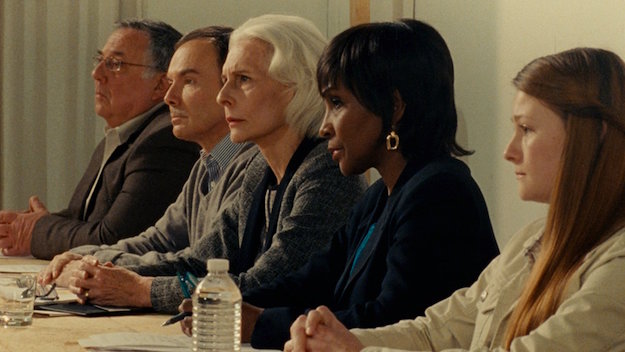
A Bread Factory
Is what led you to do it the fact that In the Family didn’t receive the recognition that you’d hoped for from festival committees?
I think that it’s very, very basic: you just feel you want your film to be seen somehow. And you’ve gone through the layers of possibility as you think through the pipeline: all the festivals have seen it, all the distributors have seen it, and you’re pretty much left with just the idea of, okay, well, you will have to be the portal by which this film is seen in the world. And you start to figure out what that is. Even with In the Family, we were theatrical for a year and a half in the U.S. So much changed in that year and a half, and possibilities kept changing [for better and worse]. The same is true now many years later that I’m distributing A Bread Factory in the U.S. It’s a very different world.
What changed in the landscape?
Some very basic things have changed. For example, certain theaters just don’t exist anymore, and I’d like to think that I was not responsible. [Laughter]
But the Quad [the lone New York theater that screened In the Family in 2011] is back and better than ever!
But it’s also a world where I can’t play my films at the Quad, because of its type of success and the type of programming that it’s focused on. So it’s just very hard to predict. And you make new friends. You see some familiar faces in different capacities. You were an audience member the first time around. Now we’re here talking about the movies and trying to make sense of it all [laughs]. The thing that has been nice is that when we opened A Bread Factory this time around, more people are paying attention. That still took a lot of people championing the film early and encouraging people to take notice. But I feel like the critical community has taken notice in a way that they didn’t quite with In the Family at the beginning. So that’s progress.
So you don’t commence each project with the intention of self-distributing?
It’s a choice at the end. I don’t have a great opinion of myself as a distributor, but even if I did, there are ways by which a film can make it into the world that are much easier and more powerful than what I, as an individual, can give it. So you always think that maybe there is a possibility, and it hasn’t quite worked out that way. Definitely not in this country. The Grief of Others had a very nice release in France, and because it had an audience, I didn’t feel like I had to bang my head against the wall trying to force it upon theaters and audiences here in the U.S. But now that I’m distributing A Bread Factory in the U.S. it makes sense [to release The Grief of Others] too. It’s a marginal effort to distribute a second film, or a third film depending on how you’re counting it, at the same time. But obviously I will expire at some point, and someone else has to take care of the movies. So what I’m looking for now is someone with a better capability than I have. But if I can’t find it, then I will keep doing it just so that [the movies are] safe. There’s no high romance about it.
There are a lot of echoes of this struggle within A Bread Factory. The other line that haunts me is “Bread was once baked here but now we live in an age of crumbs.” Followed by the more affirmative “But what we do with those crumbs is miraculous.” That doesn’t just refer to community theater in upstate New York, does it? It has broader applications.
We tell the story of a community arts center, but I think it’s a picture of struggle familiar to many other community-based, politically based, or minority-based groups. It’s a struggle on very limited means. And from what I see of these groups all around the world, those means seem to be getting smaller and smaller. So not only do you fight this impossible battle but it gets harder every year. I see it in a lot of political realms, I see it in a lot of civic institutions, and you see it in newspapers. You see it everywhere. This film was inspired by a lot of my touring with my film, seeing a lot of these community theaters and small-town cinemas. And then in France too. I would go to a theater in a small town in France and they would be so excited to see me and I would be so excited to be there. And I thought it was hysterical because you look at it practically: we’re doing nothing for each other. Nobody knows who I am. I’m bringing maybe two people to this cinema, and they’re bringing a handful of euros to our box office. Yet we are so happy to see each other. I think that there is sometimes a loneliness to a struggle and that if you just take care of that loneliness, that can help. Sometimes seeing a familiar picture, even if it’s not exactly your thing, is encouraging. And it’s what I hope this film can be to people directly in these worlds, but also engaged in their version of the struggle. Or working towards something they believe in, in a world that does not acknowledge or reward that.
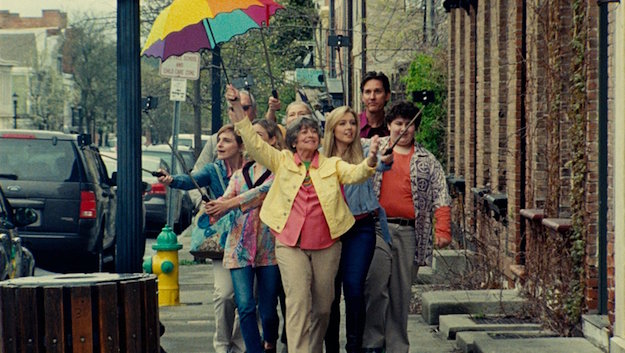
A Bread Factory
Two things strike me about Dorothea, Tyne Daly’s character. One is that she comes from a time when public funding of the arts was taken more for granted because it was just seen as a necessity. Whereas now a lot of people think of it as a luxury or even, you know, a millstone. But she also functions like a like an old-time politician in the town creating jobs for people who are out of work and recruiting people at the local diner. And that seems to be a very powerful and too little articulated point about how the arts can activate a community.
Both those things are very true. It’s been a while since I’ve read de Tocqueville, but if I recall he has some observations of how disposable the arts are in civic life in America. So that might have been a struggle for a long time. I think Dorothea is of a generation that I believe fought a lot for it and maybe made some progress, and then that process in her lifetime has likely been eroded and accelerated in its erosion in the last decade or two. There is a conversation that I know is sometimes made about the economic value of arts for local communities and of arts in education. Like some other people, I have some reservations about waving that banner because essentially it reinforces the economic metric or lens by which we see all these things. I think an important part of talking about art in our lives is understanding that we should be summing up different things than in dollars sometimes. I went to MIT, and there was a very insightful push for humanities on campus, at one point, and arts in people’s lives every day including a lot of sculpture. The basic idea behind it was that at MIT you have people who have the ability to build the weapons that can destroy the world. And people with that kind of power, you want them to have some humanity to them. So it was a case that had no economic basis; it had a very humanitarian basis.
And to the other point about the arts as giving purpose, enrichment, and employment to community members, that’s also fundamental to Dorothea and to the film.
A lot of people look at the climax of Part One as being in the school board meeting. I think the weight of Part One comes after that, in the scene with Max, who’s not an artist. He goes to plays mostly because he has a crush on this one actress. But suddenly he’s put on stage to read a monologue, and it’s a monologue of regret and loss. And it’s what he’s feeling at that moment. And it’s art helping him make sense of this. Sorting out the feelings he’s having, and at the same time it’s pulling him outside of himself into somebody else, so that he can actually see. And in a different sort of film, with a different sense of purpose to all these things, [that scene would be] Max’s gateway into becoming an actor. But [A Bread Factory] is very different in how it views art, in that it has a place in our lives. That makes in my mind a much more beautiful case for the arts than all the talking they do during the board meeting.
One of the benefits of the extended runtime is that we get to see a lot of the art that’s made at the Bread Factory. Some of it is electrifying, and some of it is kind of endearingly amateurish, but in tandem it makes such a poignant case for the necessity of these places where people can express themselves even if the result is not polished, even if it’s not commercially viable. Besides being inspired by your travels on the film circuit, does this also goes back to your fringe theater days in Boston?
It does. I feel so very lucky to in some ways. I’ve come to arts a little late. It wasn’t until I was in college, and in a setting that wasn’t a conservatory or a professional arts setting. And it was what I needed, to be allowed to think that I could participate. You learn to pursue things out of sometimes pure joy for the thing. It’s like, oh, this person asked me to do their thing—it’s not all about the great art of that play. It’s just, oh, I want to work with this person. I want to spend time with this person. And that’s a great thing. I think a lot of people don’t let the arts be part of their life because there is the sense that it must have some professional or polished purpose or result at the end of the day. Once you free yourself of that, it’s wonderful.
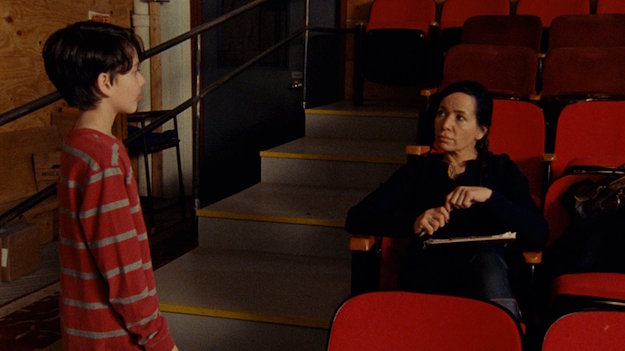
A Bread Factory
Your encouragement leads to my next question, which is about the role of mentorship. That’s another powerful theme in the film: Dorothea and Greta, but also Glynnis O’Connor as the editor of the newspaper and even Janeane Garofalo as an independent filmmaker, empowering the kids to go home and tell their parents to make dinner with more passion. [Laughter] It’s seems to be this thread of past generations inspiring present ones, which seems to be a necessity for galvanizing passion.
I didn’t see the theme so strongly as I was writing it. I was personally more just thinking of my specific mentors and all the people I’ve learned from. And it ends up being a long thank-you note to those people. They were very essential for me and I learned so much from them.
Could you talk about some of them?
In theater it was a lot of my directors. And you know, there is no shortage of images and stories of gay men and what they’ve contributed to theater. But a lot of my directors and designers and people I worked with were lesbians, and they did a lot to keep productions and theater companies together. I wanted that picture in there. And when I worked as an economist, I had a project leader who did tell me once, very loudly in no uncertain terms, “You screwed up!” So that makes its way into the film. But it’s something I remembered, and it was exactly what I needed, that shock. So with Janeane’s filmmaker, I remember years and years ago, when I first was watching videos of John Cassavetes, the thing that struck me is he seemed so angry. Why is he so angry? I’ve since learned 1) reasons to be angry, and 2) it’s not quite anger… There have been people like Cassavetes who teach us in his films but also in his living, how to see the world and how to deal with the world, and how to move through it independently. Without holding onto ideas but at the same time not over-romanticizing what’s going on.
You mentioned Cassavetes in some of the interviews that you gave for In the Family. You talked about being new to cinema. Have you caught up? Have you watched a lot of movies since then?
I am completely caught up now [laughs].
Though your films are unique, I see everything in A Bread Factory from Frederick Wiseman in the way that you mine great drama and tension out of mundane board meetings and things of that nature, and also Christopher Guest in the affectionately comic portraits of the locals of this town. Are you absorbing influences as you go, and paying homage?
I think that’s fair. I’m not always aware exactly of [influences], except for a few instances that have direct lines into things like specific things I do in the film. I know that I have little hat tips to directors or to films, but for the most part I don’t make explicit connections. It’s definitely more subconscious. It’s also just that I am an audience member, and I love to find films, books, and music. Ever since I was a kid I’ve always found things in this ad hoc way. It’s the freedom of not being part of any kind of regimented procedure, form, curriculum, and of just being able to follow your curiosity. A lot of films I see are from individuals that tell me [about them], or sometimes it’s something I happen to see on a shelf somewhere. Or I’m at a festival and I happen to have free time.
Maybe what put that in my head was just how eclectically you cast your movies. You seem to draw from the whole array of the performing arts in A Bread Factory. You have industry veterans like Tyne Daly and Glynnis O’Connor. You have people that are going to be new to a lot of viewers, like Elisabeth Henry, who is magnificent, and theater legends like Brian Murray. And Nana Visitor, [a Deep Space Nine alum] who I used to talk to at Star Trek conventions.
A wonderful woman.
You’ve credited your casting director for finding a lot of these people, but what do you look for, what do you ask for?
I like compassion from actors. I always look for compassion they have for their characters, for others. I like an intelligence to them, that we can communicate. And I like that they work hard. Those were the three things that I traditionally have looked for. Fortunately as I’ve gotten a little older, I’ve gotten a little more flexible in things and I understand that there is a wider array even of what I imagine are the backgrounds and experiences and temperaments and work styles that can fit into a film. In the audition room, what is very important to me that’s different from some of my colleagues is that I care less about where you land in that moment in the room than how we move together, how we communicate together, and how we can affect a change in your performance if that’s what’s needed. Sometimes it can come from very traditional actor training, language, and tools, and sometimes the ability to move together can be more intuitive and less formal.
What is Elisabeth Henry’s background? I couldn’t find very much on her. [Henry plays Greta, co-founder of the Bread Factory with Tyne Daly’s Dorothea.]
She’s local to the Hudson area, so she’s right across the river. She was part of the local talent pool that we auditioned. She does theater in the area. I believe she’s just had some small roles and in short films and some features. But in some ways her life may not look too different from Greta’s, as the heart of it is local performance. Just the idea of that is nice, but in addition, she’s a tremendous actress. She’s called upon to do many difficult things in the film and she could execute them, and especially with the Hecuba [excerpts], which is classical performance, in a classical verse drama.
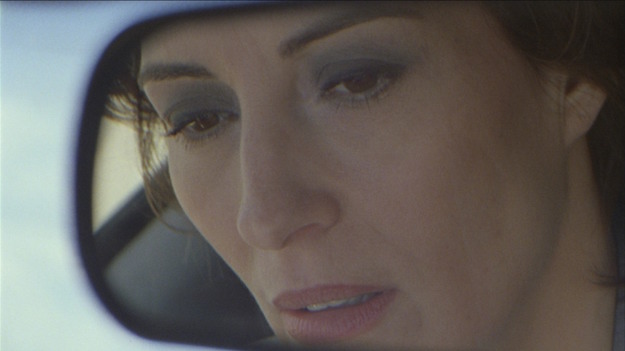
The Grief of Others
Do you ever write roles with actors in mind? You’ve worked with Trevor St. John on all your films.
The first time I’ve done this is with [the character of] Sir Walter for Brian [Murray]. So that’s not a bad start [laughs]. The rest of the time I don’t, really. It’s probably because I don’t know at the beginning who these characters are, and so it’s hard for me to cast if I don’t know who the character is.
Did you did you intend to play Joey in In the Family or did that just happen?
At the beginning, no. It was my producer who pushed me to consider it. It was more practical than anything else at that point. It’s a lot to ask for from another actor. It’s a lot of time to dedicate, a lot of work on the role, and a lot of work to work with me, somebody who had such specific views of the role.
You auditioned yourself?
I auditioned myself. I also didn’t intend to direct it… The responsibilities accumulate sometimes in independent film, out of necessity.
“May/Ray” are the encroaching performance artists who are threatening to take away the funding from the Bread Factory, and it’s interesting how they function in the story. They’re not as mainstream as the types of films that gobble up all the funding, but they also do provide their own pre-recorded applause, so they make the audience superfluous. Whether there’s anybody in the seats or not, does not really affect the way their pieces play.
There are different levels to it. For what ostensibly goes by the name of independent film, a lot of that functions in the same way. There is this manufactured applause to go along with it. I like the danger of what May/Ray sets up: pitting one type of art against another. Which I think is a false choice. What I regret is these winner-take-all markets for attention and for art, where one entity takes up all the air in the room, picks up all the resources in the community, and takes up all the attention in the community. I am fine with May/Ray flourishing, as long as there is a space by which a place like the Bread Factory can still exist. But it seems like the systems as they are set up now are not content with that sort of division. As long as somebody has a crumb somewhere, they will be found out. That’s the kind of system that I’m against and I think it creates all sorts of strange pressures on everyone.
But you think there is a place in the artistic landscape for the May/Rays. You don’t think that they are just pandering and disingenuous?
You [come to] realize that May/Ray actually are not cynical in how they create art and that it comes from a spark of joy and creativity that in some ways is not too different from me. I think as they move along, they don’t necessarily deepen their ideas. But there’s always been art of limited depth that is popular. That is part of human society, human history. And I’m not trying to rail against that. It’s one of those “render unto Caesar what is Caesar’s” [situations]. And there will always be a Caesar. But I would like for there to be a god too.
Do you think that there are those in the community who see depths in their work that don’t exist? I’m thinking of the critic who praises them fatuously: “What could be more Chinese?”
I’m glad you brought that up, because I do think that that is one of the points in which I start to have some problems with the space that a group or an act like May/Ray would occupy. There’s nothing wrong with having fun or with popular art. It’s when something starts to occupy a space by which either it pretends [to operate] in the space of deep reflective thinking, or others ascribe that to it. The contemplation that we should as a society engage in. Because then it seems to be pushing out the obligation or the space for something of what I think is truly questioning and insightful or thoughtful, and saying, no, we’ve already done it. For example, I think that often happens in the world of film, and regretfully it happens to young filmmakers, right? We have this system by which there’s sort of a little lottery for young filmmakers. When they win that, they go on the genius pedestal. I feel like in our conversations about films that doesn’t do us any favors, but also to those filmmakers. That’s very hard.
Part Two of A Bread Factory introduces a new element that takes us a bit further afield from the naturalism of the first part. Now we have impromptu musical performances and integrated tap routines. Is it to you a statement on how everything is performance?
The starting point was less that, though I’ve heard a number of interpretations start there. For me, where I started was just the different texture of it. Like you said, in Part One it was realism with maybe a few cracks. Then other things tear at that realistic texture you had in the film, and that aligned with the content of these invading forces: how do you feel this town changing? This is one very easy way to reflect those changes and these kind of alien forces at play. One of the things I like about these performative kinds of acts is that it also keeps me seeing them as human beings with something to express. It’s very easy for me to feel very uncharitable to these forces that I’m very suspicious of, very resentful of what they’re doing to this town [realtors, oblivious tourists, etc.]. But if you keep them people in some way, and if this way is by performance and needing to express something, it keeps some path of empathy open towards them. A third use is that Part Two is a lot about distraction, which I think is a very contemporary challenge: how we’re distracted. And part of the essence of distraction is that it is sort of fun, it’s very easy to tune into.
Talk more about what you mean by distraction.
You can think of it very literally as we had a story we were working on, that we were telling about this town and its people. And suddenly this whole new person comes in. We don’t know anything about them. They’re doing something that feels like a different movie. So there they seem to be distracting us from what we were building. In present day there are distractions from the important things in our lives, our contemplations about life. We fill them with all these other things that pull us away from paying attention to maybe the more important things. So that to me feels like a lot of contemporary living.
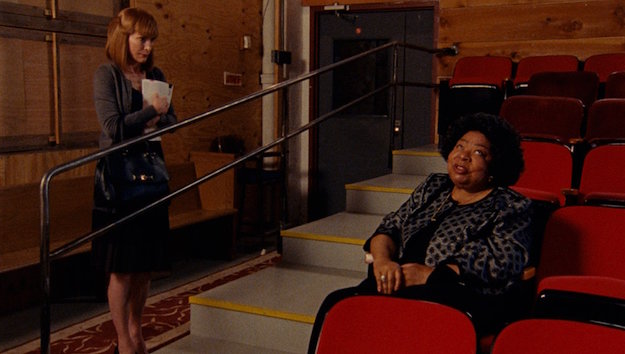
A Bread Factory
It’s distracting and also sort of pulling back, because the first narrative is focused on saving the Bread Factory, or not. And then the elements in Part Two situate it in a larger picture.
In a larger picture, but also Part One is much more classical in its form.
It’s goal-oriented.
Yes, it has a defined struggle. And that to me feels like the struggle of maybe 20 years ago. What feels to me like the contemporary struggle is making sure people know that there is a fight at all. Or maybe you know a lot of what happens in Part Two. Things slip away before you realize—you lose things before you realize. That feels a lot like living now.It’s a question of continuity. For many of these institutions, for many of these spaces, for the space that we shot in at Hudson, the theater is an operating theater that is an operating arts hub. How will it continue to be in a decade is a question that hangs over the minds of its founders.
The founders of the Bread Factory complete each other in a lot of ways. Dorothea brings the passion, Greta brings the diplomacy, to put it very reductively. Do you gravitate more toward Dorothea or Greta?
I do love them both. I think that I naturally gravitate a little more and my stories gravitate a little more towards the things that are easier to miss. And some of the beauty of what Dorothea does is easier to miss. It doesn’t seem on the surface as warm and inviting as Greta. But I am really moved by how Dorothea takes care of people. You know, without any kind of show. How she intuits their needs and how easily she places them front and center. After the board meeting, where she could have lost her life’s work, when she sees this young kid, she can [choose to] place at his feet the blame for endangering her space, or else she can see where he is and what he needs and attend to that. And there’s no question; the idea of lecturing him is the last thing on her mind. When she sees somebody hurting, she attends to it. Usually we’re used to seeing—especially in film—these very ostensibly kind and saintly souls. And she works differently. She has an armor about her. And she takes care of her enemies too, and to me that’s quite an extraordinary act. Those types of people are easily overlooked and don’t quite get the credit for their actions. That’s a reason I like spending a little time with Dorothea in those kinds of moments.
Tell me about working with Tyne Daly, playing that role. It seems tailor-made.
One of the things I appreciate most about working with Tyne was that she was a wonderful leader to the rest of the cast. It was a big sprawling cast, and they take some cues from me, but they take their cues from their leading lady, particularly if it’s somebody with the stature of Tyne. And she behaved so well. At times it’s challenging: we had such limited resources, both in terms of personnel and in terms of money, that there’s a lot you could complain about if you wanted to. She never did. And she always paid attention, she was always ready to work, always worked hard. That set a beautiful example for the entire shoot. I love, as an actress, how she attends to details. All our questions were really about such small moments and about objects. I love that that’s where she invited a collaboration. The words were already there. This scene is already there. And she needed a collaborator in organizing some of these details around her and navigating some of the details so that it felt honest to her. The way she moves with her objects and in her environment is a big part of her character. I love actors who question something when it doesn’t feel right, and she had no qualms about doing that.
How hands-on of a director are you?
I feel like my first job as a director is to observe what is happening with the actor. Not just to say what I want different but to imagine the different paths by which we get to where we need to get. Sometimes that means being absolutely hands-on, being extremely specific. And sometimes it means doing almost nothing. Maybe it’s just asking for another take. So it changes moment to moment, it changes actor to actor, and then it changes moment to moment for an actor, because they’re performing in real time. It’s a real-time psychology, and they’ll be somewhere different now than they were 10 minutes ago. You just have to be attentive to that and then try to figure out what will help them. Sometimes a lot of detail will help them, a lot of words out of your mouth will help them. And sometimes it’ll confuse them and just destroy things.
Would you say as a director that you’re becoming more of a formalist, growing more comfortable experimenting with form and technique? I’m thinking of the superimpositions in The Grief of Others. Or is that, too, just in the service of the story?
I think it’s the most deeply I’ve ever been in service of the story. It’s also the most formal and structural. At the same time it’s deeply experimental too. It’s along the lines of when you think about comedies. Oftentimes you are of a genre of comedy, you never really mix elements of comedy, and that makes no sense to me. Because many different types of things are funny. It is like a novel that uses only one literary device. It’s kind of strange, and feels a little limiting. Those kinds of choices as to “are you going to be this or are you going to be that?” —I think things can be simultaneously both.
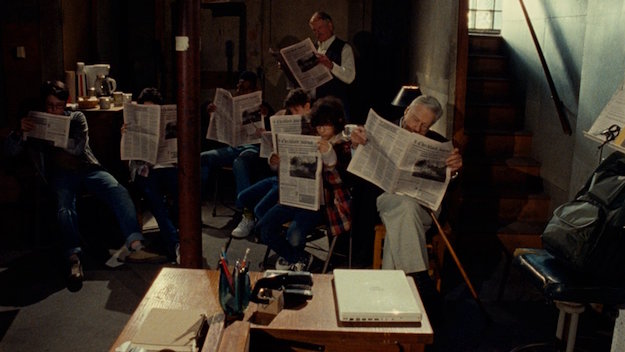
A Bread Factory
I only have one more question, which recalls the last interview you gave to us. You said, “With the experience of In the Family, at first what feels like an injustice or a source of frustration, you learn a lot from it. What I learned was: I love this film, and, simultaneously, I’m so frightened for this film, precisely for the reasons I love it.” Does that fear still exist? And is it a creatively constructive fear?
I don’t know that it has any impact on creativity or the creation process, because it’s after the fact, what you feel. In the midst of making, I’m just enthralled with the questions and the thing in front of us forming, that I don’t really think about its path later in the world. Then you realize that the world is not all copies of you and that this perspective is not shared across the board. So it becomes a hunt for those souls that have some commonality with you, and who can have this kind of explosive feeling you have when you engage with this thing. There’s a little less of the shock when the world shrugs at first—by now it’s routine. But who sorts out on which side of the aisle is always a surprise. The people you think will come through for you, won’t quite. And then you’ll end up with these new friends you never imagined.
It seems like the biggest blight is risk aversion. Even worse than people who commit to things that are awful are the people that just don’t commit.
I believe that there is a lot in my films that is accessible to many people. The question is: are they accessible now? In that particular moment of the day to them. And I think that that window is narrow. Part of the reason is that some of us are not as exercised in being open-minded to something different, something that works differently on us. Or we feel we have not succeeded if we don’t get messages back from the film that we’re correct, our experience is right. As opposed to exercising more flexibility with engaging with the film on its terms. Then there are other practical limits to just how people even hear about these films to begin with. But I think the fundamental difference between me and some of my colleagues is that I don’t change the film because of any of this. I know that there will be people who miss things about the film, who will dismiss the film for certain reasons. I don’t think that’s a reason to move the film toward them, to where they are today. I think there’s always a richness in every moment, there’s a full stream of information and meaning. And I have the confidence that if they don’t do it today, that maybe there’s a path by which someday it will be accessible to them. There’s no limit to them as a person that prevents them from accessing these things.
I find that in almost all instances, I enjoy a film more the second time. The first viewing tends to be about trying to bend the film to your will. The second time you enter into this compact that you’re going to take it on its own terms because you know what it is. And then you get more out of it.
There is also this idea of, by what do we measure the value of a film? I was reminded when I watched [Rivette’s] Out 1. The first one or two episodes to me is about 90 percent frustrating [laughs]. But then you’ll just get this moment with a kind of humor or some other kind of perspective which you’ve just never seen before! So a thing of value isn’t necessary the thing that makes you feel comfortable and wonderful every single moment along the way, or that makes you feel a consistent thing along the way, or even that you would agree with along the way. But something new and rare can overwhelmingly make the case for the value and the place of something. I forget that sometimes. Because we’ve talked about works of art in terms of perfection, and perfection is a moment-to-moment kind of thing. And I think some filmmakers make art from that perspective. They want it to be perfect moment to moment.
Steven Mears received his MA in film from Columbia University, where he wrote a thesis on depictions of old age in American cinema.



